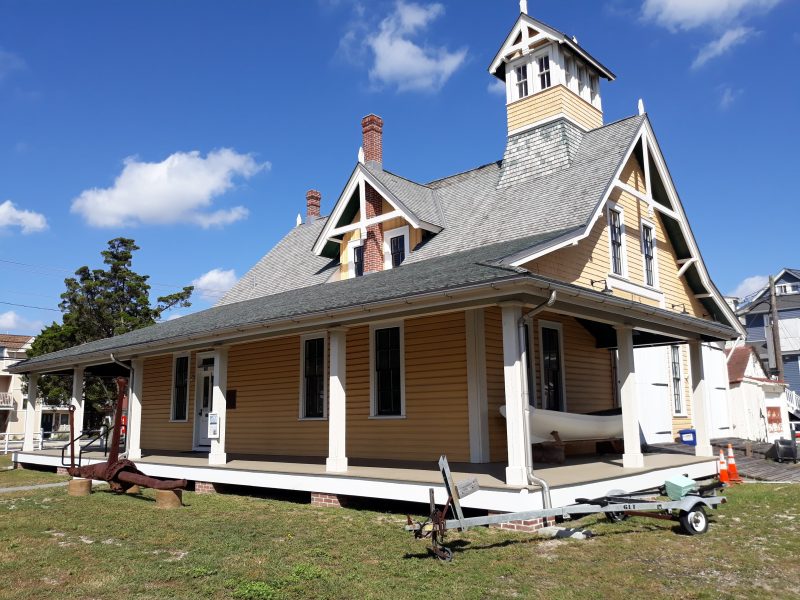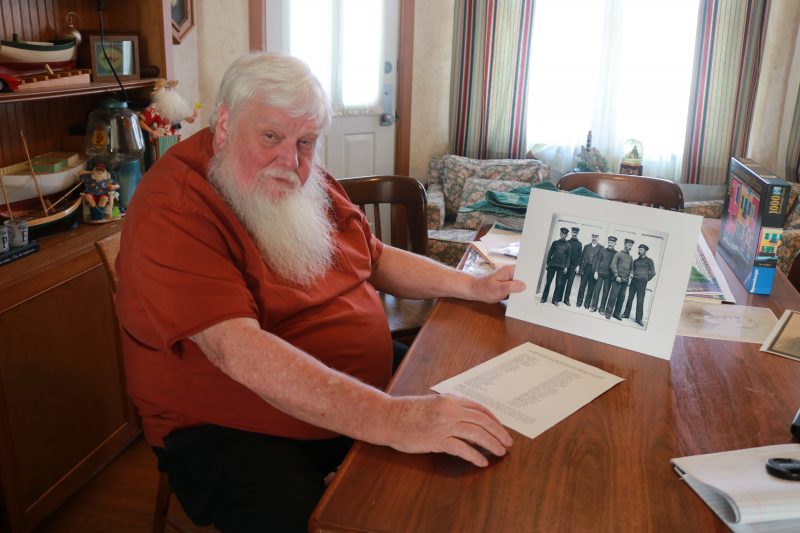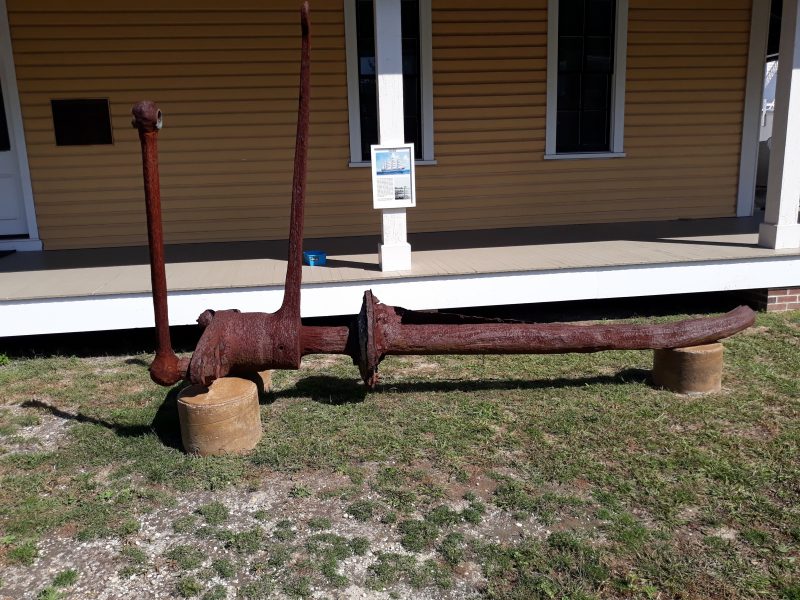The top of the rudder post recovered from the remains of the 1901 Sindia shipwreck is on display on the museum grounds.
 By DONALD WITTKOWSKI
Ever since the Ocean City Life-Saving Station opened as a “living museum” in 2017, visitors have been treated to an authentic re-creation of what the building was like in its early 20th century heyday.
But that is only on the first floor. The second floor of the architecturally striking yellow building, though, has been sealed off to the public, as if some great treasure more than 100 years old was locked behind the doors to protect it from prying eyes.
Actually, it’s not that dramatic. The museum has been slowly going through a multiyear transformation that is about to enter its fourth and final phase – the renovation of the second floor.
“It’s exciting. It’s the end. It’s taken a long time, but it’s getting accolades,” said John Loeper, a local historian who serves as chairman of the museum.
City Council has approved a $151,352 construction contract for the second floor renovations. Loeper said the project will get underway this week and is expected to be completed by March.
“So at that point, the station will be completely finished,” he noted.
The second floor will include the re-creation of the main bunk room where the “surf men” who occupied the life-saving station had their sleeping quarters, including their beds, lockers and the trunks they used to hold their personal items.
When needed, the surf men would rush to the rescue of distressed or sinking ships. If one was spotted close to shore, they would frantically take action, either launching their lifeboats or deploying a rope-operated system to save the ship passengers and crew.
Renovations on the second floor will also include the keeper’s room. The keeper was the man in charge of the life-saving station. Reflecting his high status, he had separate living quarters from the surf men he supervised. Artifacts and furnishings in his room will include a bed, a dresser, a rocking chair and a small writing table, Loeper said.
By DONALD WITTKOWSKI
Ever since the Ocean City Life-Saving Station opened as a “living museum” in 2017, visitors have been treated to an authentic re-creation of what the building was like in its early 20th century heyday.
But that is only on the first floor. The second floor of the architecturally striking yellow building, though, has been sealed off to the public, as if some great treasure more than 100 years old was locked behind the doors to protect it from prying eyes.
Actually, it’s not that dramatic. The museum has been slowly going through a multiyear transformation that is about to enter its fourth and final phase – the renovation of the second floor.
“It’s exciting. It’s the end. It’s taken a long time, but it’s getting accolades,” said John Loeper, a local historian who serves as chairman of the museum.
City Council has approved a $151,352 construction contract for the second floor renovations. Loeper said the project will get underway this week and is expected to be completed by March.
“So at that point, the station will be completely finished,” he noted.
The second floor will include the re-creation of the main bunk room where the “surf men” who occupied the life-saving station had their sleeping quarters, including their beds, lockers and the trunks they used to hold their personal items.
When needed, the surf men would rush to the rescue of distressed or sinking ships. If one was spotted close to shore, they would frantically take action, either launching their lifeboats or deploying a rope-operated system to save the ship passengers and crew.
Renovations on the second floor will also include the keeper’s room. The keeper was the man in charge of the life-saving station. Reflecting his high status, he had separate living quarters from the surf men he supervised. Artifacts and furnishings in his room will include a bed, a dresser, a rocking chair and a small writing table, Loeper said.

 John Loeper, chairman of the Ocean City Life-Saving Station, displays an old photo of the surf men who responded to the famous Sindia shipwreck in 1901.
The museum, though, will be open for tours during New Jersey’s Lighthouse Challenge on Oct. 17-18. The annual event allows visitors to explore New Jersey’s historic lighthouses and related museums to help raise money for their preservation and restoration.
Loeper said the museum will open its doors and windows during the Lighthouse Challenge to create an open-air environment that will protect visitors from the spread of COVID-19. Other safety protocols will be in place, including limiting the number of people allowed inside the building.
“We figure that it’s a building that can be safely opened,” Loeper said.
In another nod to the Ocean City museum, the U.S. Life-Saving Service Heritage Association plans to hold its annual meeting there in 2021. The meeting date is still unknown, but will probably be in September or October, Loeper said.
By hosting a national group such as the U.S. Life-Saving Service Heritage Association, the museum will be able to showcase itself “to the world,” Loeper said.
The main mission of the U.S. Life-Saving Service Heritage Association is to save and preserve life-saving stations across the country. Loeper said that the Ocean City Life-Saving Station’s transformation into a museum will serve as a “how-to” guide for the renovation of other similar buildings on the East Coast.
One thing that may perplex museum-goers is the life-saving station’s inland location, more than a block from the ocean. It was not always that way. Loeper explained that a powerful coastal storm in the early 1900s dramatically reshaped the island’s shoreline.
The life-saving station, once located on the oceanfront, didn’t move during the storm, but the beach did. A huge swath of sand was pushed in front of the station when Ocean City’s beachfront was reconfigured then. Now, the building is landlocked.
John Loeper, chairman of the Ocean City Life-Saving Station, displays an old photo of the surf men who responded to the famous Sindia shipwreck in 1901.
The museum, though, will be open for tours during New Jersey’s Lighthouse Challenge on Oct. 17-18. The annual event allows visitors to explore New Jersey’s historic lighthouses and related museums to help raise money for their preservation and restoration.
Loeper said the museum will open its doors and windows during the Lighthouse Challenge to create an open-air environment that will protect visitors from the spread of COVID-19. Other safety protocols will be in place, including limiting the number of people allowed inside the building.
“We figure that it’s a building that can be safely opened,” Loeper said.
In another nod to the Ocean City museum, the U.S. Life-Saving Service Heritage Association plans to hold its annual meeting there in 2021. The meeting date is still unknown, but will probably be in September or October, Loeper said.
By hosting a national group such as the U.S. Life-Saving Service Heritage Association, the museum will be able to showcase itself “to the world,” Loeper said.
The main mission of the U.S. Life-Saving Service Heritage Association is to save and preserve life-saving stations across the country. Loeper said that the Ocean City Life-Saving Station’s transformation into a museum will serve as a “how-to” guide for the renovation of other similar buildings on the East Coast.
One thing that may perplex museum-goers is the life-saving station’s inland location, more than a block from the ocean. It was not always that way. Loeper explained that a powerful coastal storm in the early 1900s dramatically reshaped the island’s shoreline.
The life-saving station, once located on the oceanfront, didn’t move during the storm, but the beach did. A huge swath of sand was pushed in front of the station when Ocean City’s beachfront was reconfigured then. Now, the building is landlocked.
 The top of the rudder post recovered from the remains of the 1901 Sindia shipwreck is on display on the museum grounds.
The top of the rudder post recovered from the remains of the 1901 Sindia shipwreck is on display on the museum grounds.